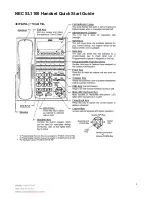
4
INSTRUCTIONS FOR ASSEMBLY, USE, DISMANTLING AND MAINTENANCE:
a) To inflate the rubber ring, first open the valve cap. Inflate by blowing or with manual inflators (never use
a compressor) until all the chambers of the ring are inflated, and they have enough pressure (when you
squeeze the ring there should be a certain amount of resistance).
The rubber ring is inflated when it starts to display resistance to inflation.
b) Once it is inflated, quickly close the valve cap so that the least amount of air possible escapes.
c) When the rubber ring has been correctly inflated, place the child in the ring, making sure that he/she is
correctly positioned and his/her legs are in the correct place. Once the child is stable in the ring, place the
open part of the ring on the adult's body, surrounded by the arms of the ring, always facing the child.
d) To take the ring off, first take the child out and leave him/her in a safe place before removing the ring
from around your waist.
e) To deflate the ring, first let it dry properly, open the valve cap, squeeze the ring until there is no air left in
the chambers, and then fold it up for storage. Squeeze the valve as shown in the diagram to get all the air out.
f) To store the rubber ring, it should be completely dry before it is folded. Place the cap on the valve in the
closed position before folding the ring.
g) For correct use of the rubber ring, the water level should be deep enough for the child not to be able to
stand up, but the adult in charge should be able to touch the bottom without being completely submerged,
and must be able to react to any possible complication (turning over, loss of pressure,...). It is advisable to
use the rubber ring with a water level that reaches the adult's chest.
DO NOT USE
•With children that are above or below the indicated weight/age range.
•At a depth where that child can stand up, near wave breakers or in bathing pools.
WARNING: Never leave the child unsupervised.
WARNING: Do not let the child bite or chew the product, parts could get bitten off and could cause a risk of
choking.
The use of nappies or any other garment or device should not cause the child to get trapped in the seat.
-Does not guard against drowning.
-Requires constant supervision within direct reach of the child and the ability to sit
upright as a requirement for using seat floats.
-Only use under constant supervision and always keep the swim seat within arm's reach.
-Always inflate all the air chambers fully.
MUM AND BABY FLOAT
CLASS A float to help babies learn to swim with PERFORMANCE LEVEL 1
This is not a water toy.
Conforms to European Regulation: EN 13138-3.
The vulnerable age-weight range of the child is: from 6 to 36 months and from 6 to 18 kilos.
¡WARNING! RISK OF TIPPING OVER
Made in China - Designed in Spain.
EN
Summary of Contents for 40332
Page 2: ...2 b d e f a c maternity...


























